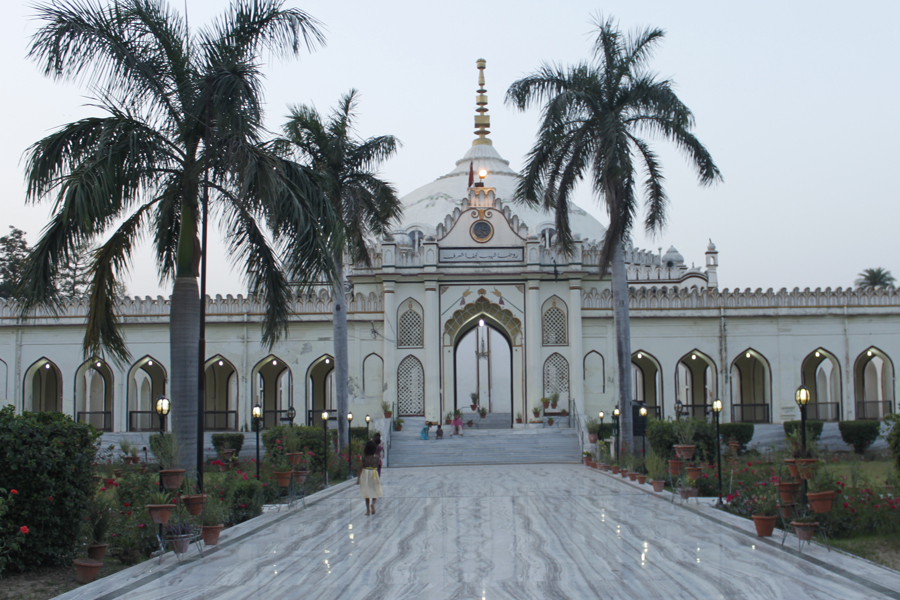
The state capital of Uttar Pradesh in northern India was once the “city of the Nawabs”, a place renowned for culture and the arts. The Mughal Empire ruled India from the 16th to mid-18th centuries and established native governors – nawabs – as semi-autonomous rulers of its states. Lucknow became the seat of power of the nawabs and the city gained a reputation as a multicultural artistic centre. In 1856, the British East India Company took charge of the city, and it came under British rule until independence in 1947. Now the city is known as one of the three that make up Uttar Pradesh tours Heritage Arc, along with Agra (home of the Taj Mahal) and Varanasi (with its ghats at the Ganges River).

The main tourist sites – both Mughal and European – are to the northwest of the city. Today, we stroll towards the Lucknow Charbagh Railway Station, said to be among the most beautiful in the world. The traffic is India-style chaotic, with trucks, motorbikes, tuk tuks, rickshaws, humans, cows and dogs all vying for space on the dusty road. Round a corner, the station suddenly appears – a palatial red and white structure with domes, turrets and Mughal arches stretching out seemingly endlessly in front of us. Built in 1914 by the British, it was here that Mahatma Gandhi initially met Jawaharlal Nehru, who would become India’s inaugural prime minister.

We head towards the General Post Office, with its impressive clock tower. Typical of colonial days, its full-length counter harks back to the days when sending and receiving mail was something of an occasion. Outside are some 80 mailboxes waiting for post. Today, the art of snail mail has lost to the prevalence of emails and WhatsApp messages.
The temperature is pushing upwards of 40 degrees C and if we were not too hot to eat, we’d be trying the Lucknow speciality- flaming-hot fried kebabs with roti bread. As it is, we stop off at a kiosk for our umpteenth cold drink. As we cut through some lowly residential back streets, a man welcomes us to Lucknow, “I’m happy you’ve come to visit”, he tells us.

We find our way to the Dilkusha Palace, a nawab hunting lodge which is a replica of an English country house. Suddenly, the hubbub of the street fades away and we are in a gracefully decaying building in tranquil grounds where small groups of people are taking a brief respite from city life.
We plan to visit the French-built La Martiniere College, originally a European funerary monument but now a leading educational institution. Today, La Martiniere College imparts instruction through the medium of English and admission to the College is eagerly sought. Over the span of one and a half centuries, the College has produced soldiers, sailors and airmen who have done the school and their country proud in the two World Wars and in the wars of Independent India.

The next day, we went to the 60 ft-high Rumi gate in the morning, marking the entrance to the Old Lucknow city. Built between 1784 and 1786, it boasts a different architectural style on each side. At the Residency ruins, we saw the famed scenes of less-than-happy Anglo-Indian relations when the Lucknow Siege of 1857 saw battle between the locals and British Raj. In fact, the seeds of India’s independence movement were sown in Lucknow.

Of all Lucknow’s impressive buildings, the Bara Imambara (Big Shrine) holds the crown. Established in 1784 by the 4th Nawab, this vast building and an adjoining mosque was also used as a meeting place. The mosque is open to all Muslims. Bara Imambara has a huge, 50 ft-high main hall, unsupported by columns. Intriguing architectural features serve to detect intruders and help with acoustics – best of all it is a fabulous upper-floor labyrinth that runs within the thick external walls.

There are two Lucknow’s: the city, where most of life goes on and pockets of each glorious past. Many of these buildings are currently under renovation: the Clock Tower which is reminiscent of London’s Big Ben – and one of India’s tallest – the Satkhanda, built in 1842 that bears a resemblance to the Leaning Tower of Pizza It was intended to have seven or nine, but the Nawab died before its completion, as did the plans for a higher building.

Despite all the renovation walk for the historic buildings, we saw only half a dozen other foreign visitors. And there is not a single picture postcard to be found in the city. Lucknow, at the moment anyway, hardly seems to market itself. Changes are happening now in Lucknow and now would be a good time to go if you want to visit as a traveller to the fascinating historical city.
How to get there?
Scoot flies from Singapore to Lucknow 3 times daily on Tuesdays, Thursdays, Saturdays.
If not, take an Indigo flight and connect to Lucknow via Chennai.



